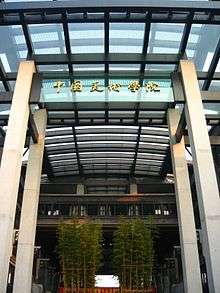China Academy of Art
| 中国美术学院 | |
 | |
| Motto | 團結 奮進 求實 創新 |
|---|---|
| Type | Public |
| Established | 1928 |
| President | Xu Jiang |
Academic staff | 500 |
| Undergraduates | 8,000 |
| Location |
Hangzhou and Shanghai, |
| Campus | Urban, Suburban |
| Colors | Black and white |
| Website |
www |
| China Academy of Art | |||||||
| Simplified Chinese | 中国美术学院 | ||||||
|---|---|---|---|---|---|---|---|
| Traditional Chinese | 中國美術學院 | ||||||
| |||||||
China Academy of Art (simplified Chinese: 中国美术学院; traditional Chinese: 中國美術學院; pinyin: Zhōngguó Měishù Xuéyuàn) (also translated China National Academy of Fine Arts) is a fine arts college under the direct charge of the Ministry of Culture of China. It was founded in Hangzhou in 1928 by the government of the Republic of China and the renowned educator Cai Yuanpei. It was the first art university and first graduate school in Chinese history. At the time, China Academy of Art's goal was to promote fine arts education as a replacement for religion in the then war-torn China. The fine arts has been held as equal to a religion at the institution for almost eight decades. The academy has many renowned artists in its alumni and is considered one of the most prestigious art institutions in the country. It is colloquially called Guomei (國美). It has tens of thousands of applicants every year, with an attrition rate of well over 95%.

Introduction
China Academy of Art is the most influential academy of fine arts with the most complete range of degree offerings and programs of study in China. It houses a diverse pool of artistic talent, has a distinctive structure integrating theory and practice, focuses on human care and social needs, and combines modern technical and cultural disciplines with traditional artistic ones. The academy features the study of theories and offering Ph.D., Master’s and bachelor's degrees of fine arts, design,architecture, film and new media, which constitute the humanities and reflect the Chinese national spirit and creative theories of the era.
There are 7,000 undergraduate and graduate students in three campuses with a faculty and staff of 800. The administration of the Academy is headquartered in the Nanshan Campus, which is located on the West Lake in Hangzhou. Students in the Master's program live on the alternate campus 40 minutes away, on the outskirts of Hangzhou. A free bus is offered to transport students to and from the campus from the dorms at designated times.
Undergraduate students typically spend one year in general education courses in the Department of Foundation and then three years in the core courses of their particular majors. Graduate courses are typically three years long and include experience in the studio and research with mentoring faculty.
History
In 1928, the National Academy of Art (國立藝術院) was founded in China on the bank of the West Lake in Hangzhou by the educator Cai Yuanpei with Lin Fengmian. Later on administrated by Yi Tingbai and Zhuang ziman during 1940s. Over the decades, the location of the academy has changed ten times and its name changed six times, as follows:
- 1928 - National Academy of Art (國立藝術院)
- the first name of CAA,National Academy of Art was the first Chinese art university and graduate school
- 1929 - National Hangzhou School of Art (國立杭州藝術專科學校)
- changed into a national art school
- 1938 - National School of Art (國立藝術專科學校)
- the War of Resistance Against Japan broke out,National Peping School of Art merged into National Hangzhou School of Art, a new national school formed
- 1950 - East China Campus of Central Academy of Fine Arts (中央美術學院華東分院)
- after Chinese Civil War,CPC(中國共產黨) controlled mainland China and founded a new art academy CAFA in Beijing,in order to cement Beijing's new capital position, and as a national academy founded by KMT(中國國民黨)government,CAA was ordered change its name into East China Campus of CAFA. But CAA only changed its name, but did not merge by CAFA, the two academies still possess independent personalities and not be subordinate to one another.
- similar circumstances like Shanghai Conservatory of Music(上海音樂學院),which first name was National Conservatory of Music(國立音樂院),Shanghai Theater Academy(上海戲劇學院) were ordered change their names into East China Campus of central academies.
- 1958 - Zhejiang Academy of Fine Arts (浙江美術學院)
- 1993 - China Academy of Art (中國美術學院)
- China National Academy of Fine Arts, called China Academy of Art for short (on November 16, with the endorsement of the Ministry of Culture, PRC. Finally, CAA was rehabilitated its national appellation.

Campuses
- Nanshan Campus, 218 Nanshan Road, Shangcheng District, Hangzhou
- Zhangjiang Campus, in Zhangjiang Hi-Tech Park, Pudong New District, Shanghai
- Xiangshan Central Campus, in Zhuantang Sub-district, Xihu (West Lake) District, Hangzhou. Its south part was moved to current location in 2007 from Xihuan Road, Binjiang District
Colleges and departments
Nanshan Campus
- The School of Fine Arts (造型藝術學院)
- The Department of Chinese Painting (中國畫系)
- The Department of Calligraphy (書法系)
- The Department of Oil Painting (油畫系)
- The Department of Print-making (版畫系)
- The Department of Sculpture (雕塑系)
- The School of Intermedia Art([SIMA]跨媒体学院)
- Open Media Lab(开放媒体工作室)
- Embodied Media Studio(具体媒介工作室)
- Total Art Studio(总体艺术工作室)
- Installation & Narrative Environment Studio(空间多媒体工作室)
- Experimental Image Studio(实验影像工作室)
- The Advanced School of Art and Humanities (藝術人文學院)
- The Department of Art History and Theories (美術史論系)
- The Department of Visual Culture (視覺文化系)
- The Department of Art Curation and Administration (藝術策劃和行政系)
- The Department of Archaeology and Museology (考古與博物館學系)
Zhangjiang Campus
- The Shanghai School of Design (上海設計學院)
- The Department of Architectural and Environmental Art Design (建築與環境藝術設計系),
- The Department of Visual Communication Design (視覺傳達設計系),
- The Department of Muti-media and Web Design (多媒體影像設計系),
- The Department of Industrial Design (工業設計系),
- The Department of Fashion Design (服裝設計系),
- The Department of Urban Landscape Plastic Art Design (城市景觀造型藝術系).
- The Department of Digital Publishing and Exhibition Design(數字出版與展示設計)
Xiangshan Central Campus
- The School of Design (設計藝術學院)
- The Department of Graphic Design (平面設計系),
- The Department of Industrial Design (工業設計系),
- The Department of Fashion & Textile Design (服裝与染织設計系),
- The Department of Comprehensive Design (綜合設計系),
- The Department of Art Design (藝術設計學系).
- The School of Architectural Art (建築藝術學院)
- The Department of Architectural Art (建築藝術系),
- The Department of Urban Design (城市設計系),
- The Department of Environmental Art (環境藝術系),
- The Department of Landscape Design(景觀設計系).
- Public Art Institute (公共藝術學院) (A private sub-college)
- The Department of Art Education (美術教育系),
- The Department of Murals Art (壁畫藝術系),
- The Department of Ceramics and Arts and Crafts (陶瓷和工藝美術系),
- The Department of Public Art (公共空間藝術系).
- Media and Animation Institute (傳媒動畫學院)
- The Department of Photographics (攝影系),
- The Department of Animation (動畫系),
- The Department of Online Games (网络游戏系),
- The Department of Film, Video and Advertising (影視廣告系).
Other colleges
- The College of International Education (國際教育學院), located at the Nanshan Campus.
- The College of Adult Education or The College of Continuing Education (成人教育學院/繼續教育學院),located on Puyan Road,Binjiang District.
- The Vocational College of Art Design (高職學院).
Notable alumni
- Lin Fengmian
- Yi Tingbai
- Xiao Chuanjiu
- Huang Binhong, Chinese Painting master
- Pan Tianshou, Chinese Painting master
- Liu Kaiqu
- Li Kuchan
- Li Keran
- Dong Xiwen
- Wang Shikuo
- Beohar Rammanohar Sinha, modernist painter from India
- Wu Guanzhong
- Sha Menghai, Calligrapher
- Zao Wou-Ki, Chinese-French modernist painter
- Chu Teh-Chun, Chinese-French modernist painter
- Luo Gongliu
- Wang Shu, first Chinese architect to receive the Pritzker Prize.
- Ying Miao, internet artist
See also
External links
Coordinates: 30°14′36″N 120°09′32″E / 30.24333°N 120.15889°E